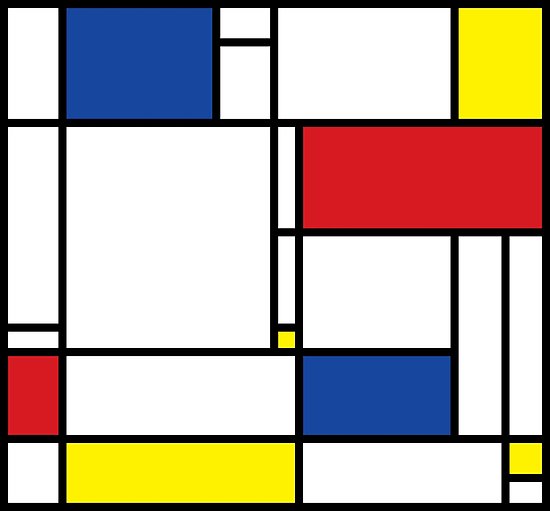The Base Collection at the Stedelijk Museum offers a unique format, in which artifacts of art and design from the same movements are displayed alongside each other, and arranged in chronological order. The purpose is to illustrate the shared narratives that exist between art and design within the same era.
The ‘Red and Blue' chair (1919-1923) designed by Dutch cabinetmaker Gerrit Rietveld, is reflective of De Stijl, the Dutch avant-garde movement in which he participated. His furniture can be seen as a three-dimensional translation of the visual language used by Dutch artists within the same movement, such as Piet Mondrian, who’s work is depicted below.
Rietveld, whose furniture is characterized by flat wooden slats, applied this approach in creating his own interpretation of a cantilevered chair, which was a very popular concept at the time, since it reflected the values of utilitarian simplicity.
Rietveld’s ‘Zigzag’ chairs (1932 - 1933)
Marcel Breuer is typically credited with the original cantilever chair design, which was made with tubular steel. However, several other designers also claimed to have originated the concept. Two Dutch designer, Mart Stam, and Willem Gispen fought for the pattent. It was ultimately awarded to Stam, but ruled that Gipsen’s design was distinctive enough that it did not constitute infringement. A German architect, Ludwig Mies van der Rohe also developed a steel tube, cantilevered chair at around the same time. Despite all of this, Marcel Breuer maintained that he originated the concept, and he has gone down in history as the inventor.
Mart Stam’s ‘B32’ Chair (1928/1929, variant 1934)
Gispen’s ‘Chair 101’ (1931)
*Not displayed in the museum’s collection
Martin Breuer’s steel tube cantilevered chairs (bottom and left)
Ludwig Mies van der Rohe’s MR Chair (1927) (top)
Meanwhile, Scandinavian designers were using curved wood to make furniture sharing the same minimalistic ethos.
Arne Jacobsen’s Series 7 (1955) Grand Prix (1957)
Charles and Ray Eames, an American couple, helped introduce the modern minimalist movement to the United States. Their affordable furniture was designed for the masses, and employed new technologies and materials.
Top: Wire Chair (1951)
Middle: Dining Chair Metal (1946)
Bottom: Dining Chair Wood (1946)
Part 2 of the Base Collection, located on the upper floor, features contemporary furniture that represent a new spin on the old. The ‘Clay Furniture Collection’ by Maarten Baas, for example appear to be made of an ancient material, however it is really made of steel encased with synthetic clay.
The ‘Chinese Stools’ (2009), made by Wieki Somers and Dylan van den Berg were inspired by improvised stools that they saw being used by street vendors and rickshaw drivers while they were visiting China. While the archetypes were made of wood and fabric, the reinterpretations displayed in the museum were cast in aluminum.
The ‘Knotted Chair’ (1996) by Marcel Wanders uses knotted carbon fiber made rigid with epoxy resin to create the look of rope made from natural fibers, but with properties that could not be achieved with the material that it resembles.
Ineke Hans’s ‘Laser Chair’ appears to be painstakingly detailed solid wood, however it was actually made by laser cutting MDF.
The temporary exhibit on display, Fragile Future by Studio Drift, seeks to explore the relationship between man, nature, and technology.
This chair, part of the Ghost Collection, reminded me of something that I saw at the Design Museum in Brussels. While contemplating what the chair of the future may look like, Marcel Breuer posited that “Year after year there will be continual improvements, and finally people will be sitting on columns of flexible air.”
They also had several light-based pieces, such as this ‘Fragile Future Chandelier 3.5’ which is made of hundreds of small modules, each consisting of an LED placed inside of a cluster of dandelion seed. The arrangement of the modules is meant to resemble the way the seed pods are dispersed and carried by the wind.
While the museum had a lot of the same stuff I had already seen in the other museums, it was interesting to see it organized in a new way. They layout of the museum itself was quite interesting, offering an engaging example of spatial design, which I enjoyed.



















